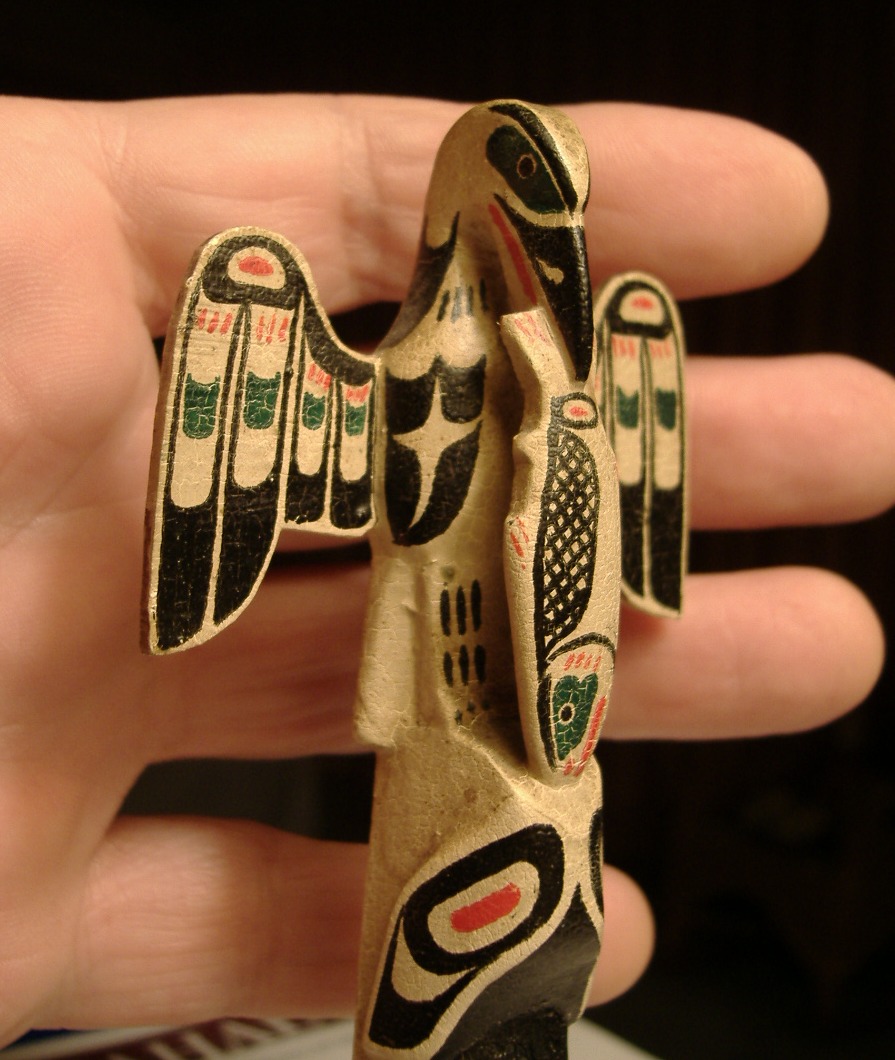..........upturned eyebrows, deep V to the mouth, half-moons at the finger-bases and trigon at the wrist;toenails, fingernails; the Walkus ovoids are slightly soft. a three-way U; several unusual ovoids filling their appropriate spaces. I know very little about the life of George Walkus, and would enjoy meeting any relatives. Please contact me. |
Willie Seaweed, immortalized by Bill Holm, who identified over 160 Seaweed pieces, most of them unsigned.... Chief George Walkus and his son Charlie... John Scow and all his descendants.... the Hunts......now, some will say they are not really Blunden Harbor...the same perhaps for Charlie James, who gave up the white undercoat----I wonder if tourists found it scary, and the plain ones sold better....but grandaughter Ellen Neel at her best could do a hard core Blunden Harbor/Smith Inlet style-- she offered buyers the choice of that white undercoat, and Pam Creasy-Neel says that's how she liked it best.....Mungo Martin of course; and Dick Price, Arthur Shaughnessy, and the rest......Walter "Longjohn" Smith... to paraphrase Hilary Stewart....."there is reason to believe in the existence of a distinct substyle of Kwakiutl art...." Characterized by that white undercoat and an increasingly florid style, an elaboration of design.... Seaweed is the best known, but there are totem poles by George Walkus that are very well-done; the one shown here is a study in the perfection of form-line. This pole, dated April 1939, has notes on the back, signed by G.H. Raley, F.R.S. who associated with Walkus and his wife for some time during the 1920's. Does not duplicate a known pole; about 24" with a very interesting weight and taper to it; top face is an unusual thunderbird with both a human and a beaked face, sadly missing a tiny bit of the beak. More pictures to come, and pictures of Blunden Harbor-style eyes for comparison purposes; from the round staring Walkus eye to the overlapped Shaughnessy-style.... |
Under construction, for sure. |
Kwakiutl carvers of Blunden Harbor/Smith Inlet |
Willie Seaweed, immortalized by Bill Holm, who identified over 160 Seaweed pieces, most of them unsigned.... Chief George Walkus and his son Charlie... John Scow and all his descendants.... the Hunts......now, some will say they are not really Blunden Harbor...the same perhaps for Charlie James, who gave up the white undercoat----I wonder if tourists found it scary, and the plain ones sold better....but grandaughter Ellen Neel at her best could do a hard core Blunden Harbor/Smith Inlet style-- she offered buyers the choice of that white undercoat, and Pam Creasy-Neel says that's how she liked it best.....Mungo Martin of course; and Dick Price, Arthur Shaughnessy, and the rest......Walter "Longjohn" Smith... to paraphrase Hilary Stewart....."there is reason to believe in the existence of a distinct substyle of Kwakiutl art...." Characterized by that white undercoat and an increasingly florid style, an elaboration of design.... Seaweed is the best known, but there are totem poles by George Walkus that are very well-done; the one shown here is a study in the perfection of form-line. This pole, dated April 1939, has notes on the back, signed by G.H. Raley, F.R.S. who associated with Walkus and his wife for some time during the 1920's. Does not duplicate a known pole; about 24" with a very interesting weight and taper to it; top face is an unusual thunderbird with both a human and a beaked face, sadly missing a tiny bit of the beak. More pictures to come, and pictures of Blunden Harbor-style eyes for comparison purposes; from the round staring Walkus eye to the overlapped Shaughnessy-style.... |

..........upturned eyebrows, deep V to the mouth, half-moons at the finger-bases and trigon at the wrist;toenails, fingernails; the Walkus ovoids are slightly soft. a three-way U; several unusual ovoids filling their appropriate spaces. I know very little about the life of George Walkus, and would enjoy meeting any relatives. Please contact me. |
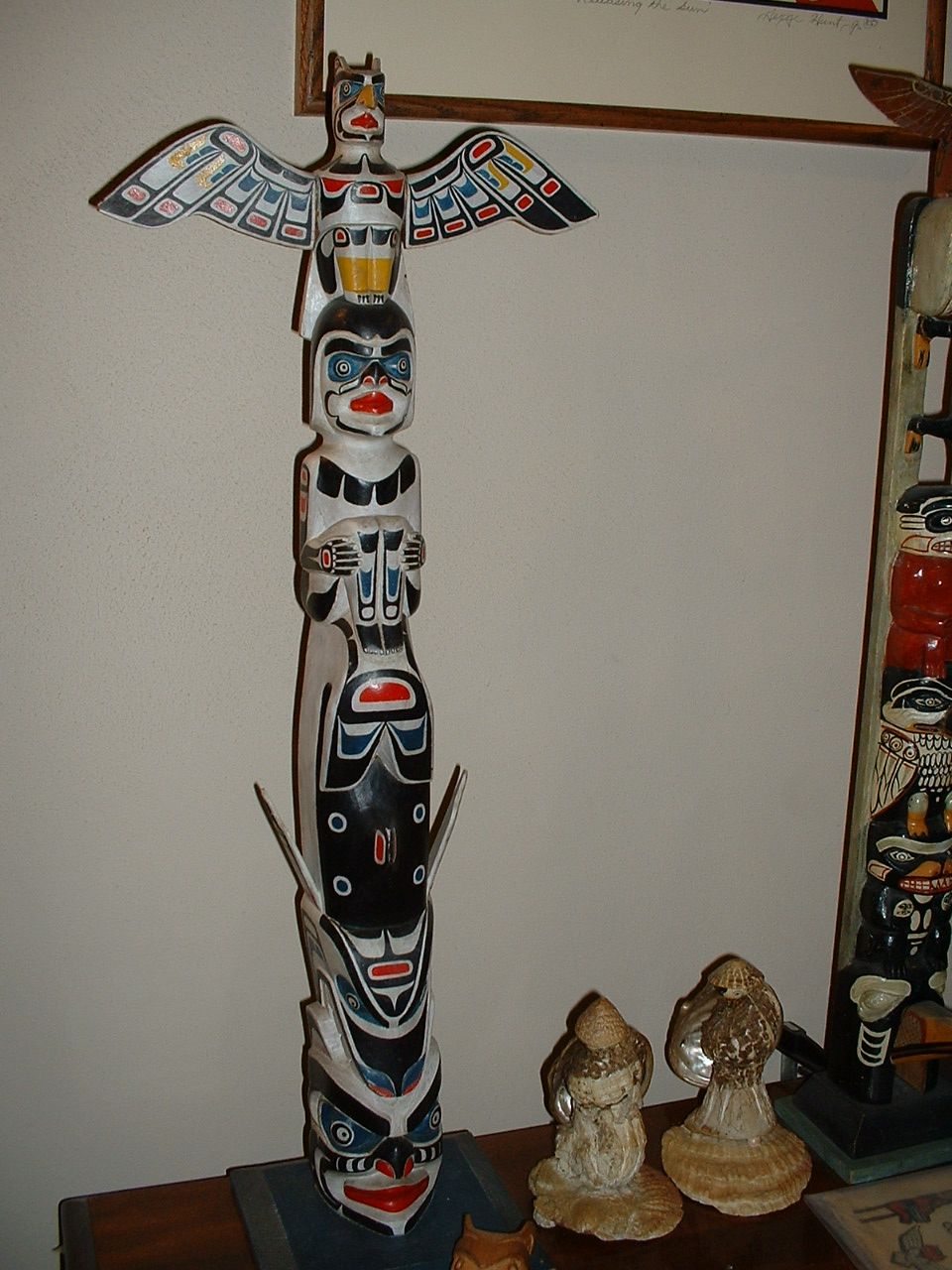
The little mask is by Charlie G. Walkus, 30 years later than his father's; peas in a pod. The Walkus eye has centers that are much closer to concentric than are Seaweed's, and a very thin outer ring, giving the characteristic Walkus "drugged" stare Where did Walkus and others get those bases? I vote for milled, as bannister-caps..... |
And another pole from the Thunderbird shop....the Talking-stick of Chief Wakius....(no relation).......this was the frontal pole on the house where Ellen Neel was born; the last of the great houses to stand in Alert Bay....tells the story of the Hamatsa dance....for a little bedtime reading..... |
THE TALKING STICK OF CHIEF WALKIUS a story of the Tlingit and Kwakiutl In the time before there were totem poles at Alert Bay, the Tlingit people of Tongas came from the North. It is said that Raven the Transformer brought them to that place as he journeyed through the world, turning the myth people into the first animals. In any case, they carved poles because it was their custom to do so in the land from which they came, and in order to show that they were not people without kin, but members of important clans, entitled to display the signs of their rank. In the land where they had settled they now called themselves Kwa'Gulth or Kwakiutl, People from the North; they were one of the groups known as Kwakwak'awakw, Speakers of Kwakwala. This is the story of how they came by the right to the cannibal dance and its great masks, and also of how the mosquito came to suck blood as it does. Anain, mother of George Hunt who figures in this story, belonged to the Raven Clan, and her sister belonged to the Wolf. More correctly her name was Ansnak, a Raven of Tongas, or Mary Ebbetts. Her people were born and had lived under the Russian flag; her Grandfather was Chief Shaiks; and her mother was of Stikine stock, a daughter of the head-chief at Wrangell. That is to say, she was of the great families, and lately come from the North. She married a white man, Robert Hunt, who was the factor of the Hudson's Bay Company, it being the fashion at the time for the factors of the Hudson 's Bay Company to marry the daughters of chiefs, so as to promote peace between the peoples; Robert Hunt eventually bought the Hudsons Bay post at Fort Rupert, and Captain McNeil who was factor under him married the daughter of a Haida chief , and their children were well known in the area, including Lucy McNeil who married Captain Moffat. Other factors under him also married other daughters of the Raven clans. In addition to George Hunt, who was of so much help to Franz Boas during his travels on the coast, the children of Robert and Ansnak or Mary Hunt were Roy, William, and Eli Hunt; Emily, Elizabeth Anna, and Jane. The generations of the Hunt family have included more than 25 artists of the highest quality. Mary Ebbetts Hunt, mother of the Hunt brother and sisters, was a skilled weaver of Tongas blankets (the type usually called Chilkat). She stopped weaving only when the Fort Rupert people began to beg her to teach them to weave like her; for she remained a loyal Tlingit even after coming to Port Rupert and taking the Kwakiutl name, and Tongas blanket-weaving was a right of her own tribe. This is the story of the portal pole, carved by Yurhwayu and his assistants for chief Wakias, for 350 blankets in a time when a blanket was worth $3.00; that was a big pile of blankets. Yurhwayu was an old man at the time, and it was said not many of those still living at that time could carve as well as he, though there were perhaps some in Blunden Harbor still, who could do so. Wakias had the right to the crests because he was of the Awikyenorh (Northern Kwakiutl) on his father's side. The story associated with the pole tells of how one of the great dances came to the Awikyenorh, who were famous among the Kwakwak'awakw as the source of many of the oldest and greatest dances and privileges. The occasion of the naming of the pole at the Great Potlatch of 1893 was often spoken of by Dan Cranmer,who was himself of the lineage of Wakias, and who gave the first potlatch in defiance of the anti-potlatch law, for which he was arrested and jailed in 1922. After the original pole was appropriated by a group organized by the Seattle Times and Board of Trade, Dan Cranmer carved a replacement; and later supervised the restoration of the original, which now stands in the Great Hall at the Canadian Museum of Civilization. When the replacement was raised there was a great feast attended by the Cranmers and other descendants of Walkius, including Charlie George Walkus, son of the famous carver George Walkus, of the Gwasila or Northern Kwakiutl. (Chief George Walkus, with Willie Seaweed, John Scow, Arthur Shaugnessy and Charlie George was a founding member of the Blunden Harbor/Smith Inlet carving style.) This was the pole that fronted the House of Walkius, the first of the great houses to be built in Alert bay, and one of the last to stand. It was the house in which Ellen Neel, the first woman carver, was born. From time immemorial the chiefs of the North had a Talking-Stick which they used at the great potlatches, carved with the crests of their lineage, but Chief Wakias arranged to have the crests carved into a portal pole; and at one potlatch Chief Wakias took a model totem pole in his hand and said "Now I must use this as my Talking-Stick," and thus the great pole was called "the Talking stick of Walkius." George Hunt tells how, on the occasion of the potlatch of 1893, he had to tease Wakias into beginning the story of his great ancestor NaWaka'Wa, and how he outwitted Bakw'bakwalanukshay, the great Cannibal-at-the-North-End- of-the-World, who had feasted himself at the expense of the tribe. This is how the people of the North got the cannibal masks, the Hokw-Hokw mask and the Raven mask, and the cannibal dance, from his mother's people the Awak'wa; because they destroyed the people to whom it belonged. And afterward they took the Thunderbird for their crest; and it is at the top of the pole. George Hunt finally had to tell most of it himself: ----#---- NaWaka'Wa was the chief of our family long ago. He had four sons, and one day as the brothers were packing their things in order to go into the mountains to hunt mountain-goats, the old chief gave them some advice: NaWaka'Wak warned them of a land where the smoke was like the colors of the rainbow, where the brown smoke was for the bear and the white was for the whale, and so on with all the colors and clans, and the red smoke was the color of the cannibals. Then NaWaka'Wa gave them a smooth pebble, an alder-wood comb, some fish oil, and some mountain-goat wool. And he said, "If the cannibals come after you, you must throw them these things, one at a time." So the young men went into the mountains on their way. And they soon came to a land where there were many houses, and the smoke from each house was of a different color, just as their father had told them. And they said, "Look, this is the land of which Father warned us. Let us go see." And they went into the first house, which had red smoke coming from the smoke-hole. Here there was a very large woman and her child. Now the youngest of the brothers had scratched himself on some brambles, and was bleeding somewhat, and the woman said, "scrape up the blood with this stick." After the youth did so, she gave the stick to her child, who licked the drops of blood from it. The brothers then began to suspect that the woman was a cannibal, since her child craved human blood. So they pretended to engage in an archery contest, and the youngest shot an arrow out through the doorway; then the oldest shot another, and the two of them ran out to find their arrows, and the other two followed in the confusion, and they all ran off. Then the woman went and called for her husband, and he came and asked what had happened, and she said the young men were searching for their arrows. Bakw'bakwalanukshway the cannibal chief, who was a monstrous giant as well as a cannibal, realized that the brothers were escaping, and he set out after them. Soon the brothers heard him whistling and snorting and gnashing his teeth behind them, and they knew he was about to catch them. So the eldest brother threw down the smooth pebble, and it became a huge mountain, with sides so smooth that the cannibal couldn't climb it, for a while. But he soon made his way around it, and once more the brothers heard him whistling and panting and grinding his teeth behind. Then the next brother threw down the comb, and it became a forest of alder trees so dense that the cannibal chief could not get through, for quite some time. But soon enough the brothers heard him snuffling and grating his teeth behind them, and the next brother threw down the vial of fish oil, which became a vast lake, such that the cannibal could not get past it, for a very long time. But after a bit the brothers heard him again, hooting and whooping, and gnashing and grating and grinding his teeth, and the youngest brother threw down the mountain-goat wool, which became a dense fog, through which the giant could scarcely find his way. But the fog did slow him down long enough that the brothers were able to reach the foothills of the mountains, and their father's house. Then they ran calling to him that the cannibal chief was coming, and chief NeWaka'wa tied a cedar rope around the house, and he and his sons hid within. Then the cannibal chief was unable to get at them, for a time. But he began to come in through the smoke-hole, so Chief NeWaka'Wa called to him, saying "Brother, be at peace, for if you wish to devour my sons. you have no need to hurry, but you may return tomorrow with your wife and child and devour them then at your convenience, for in truth they are worthless boys and of very little use to me" So the cannibal chief went away, and Chief NeWaka'Wa and his sons made preparation for their return; they carved a large settee in the form of the Sisiutl or giant two-headed sea monster, (some of the poles of Walkius have the Sisiutl, but this one does not, it was on the settee instead) and they killed four dogs and pulled their entrails out (the dog or Wolf appears on the pole, and also is present as a matter of right, for the sister of Walkius was a Wolf; and the Bear appears because Wakius married a woman of the Bear clan.) And they took many of the big rocks such as are heated for cooking, and they put them in the fire. The brothers then lay down as if they had been killed and their intestines torn out, and they pretended to be dead. When the cannibal chief and his wife and child appeared, Chief NaWaka'Wa said to them, "Here is your food, but first you must sit, for it is our custom before we eat to tell a story." Then the cannibal chief and his wife and child sat down, and Chief NeWaka'Wa told them a long story about his family and the origin of certain crests and privileges...much like this present story. And the chief shook his talking stick, which was carved in the form of the pole with the crests on it, and there were pebbles inside the talking stick which made a soothing sound, and soon the cannibals fell asleep. Then the four brothers leaped up and pulled the settee apart, so that the cannibal chief and his family fell into the pit; and the heated rocks and the coals were thrown in after them, so that they were entirely burned up and their ashes floated out through the smoke-hole. Chief NaWaka'Wa cursed the ashes, saying "You will become mosquitos and biting insects like the horsefly, and will suck the blood of men." Then Chief NaWaka'Wa sent his sons to the village of the cannibal chief, to see if there was anything there that might be of use. And the brothers went there and found, in addition to a great amount of mountain-goat meat, the great mask of the Hokw-Hokw, the giant bird that cracks men's skulls to eat their brains, who is sometimes called the supernatural mosquito; and the mask of the Raven. And there they are on the pole, with the other crests and even Bakw'bakwalanukshway himself. And thus the brothers returned with the cannibal dance, as was their right, for they had defeated and utterly destroyed the people to whom it had belonged. The dance is the story of how the cannibals were overcome by our people. (summarized from the usual sources by Steve Akerman) |
It seems the people were victimized by a thunderbird who kidnapped their shaman; the people disguised a canoe as a whale or sea-monster, which the bird also like to eat; and, covering it with pitch, they waited therein. When Thunderbird swooped down he was trapped, and the people came out and killed him. Pole showing thunderbird, shaman, sea-monster, and mask of the chief. |
Pencil-lines from layout still visible, very precise. |
Wonder what the expression was like when the beak was complete..... |
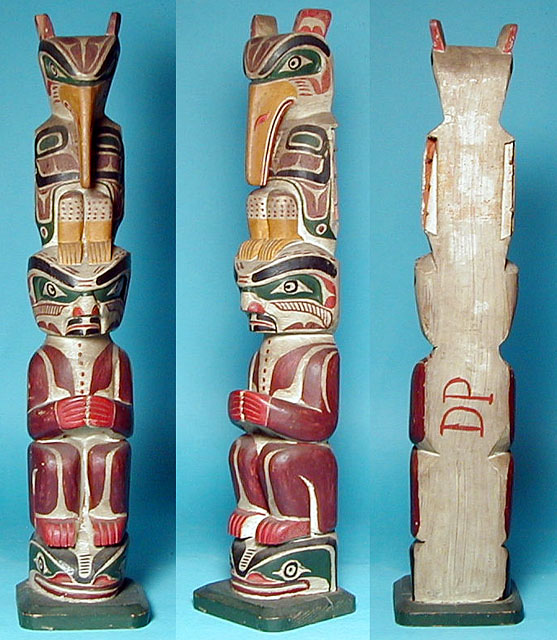
Pole by Dick Price; missing wings, sadly. Thanks to S.H. |
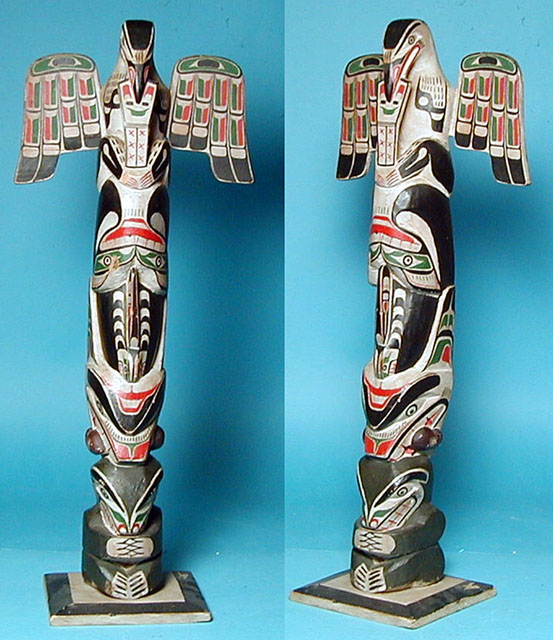
Chief George Walkus: Magnificent pole Thanks to S.H. |
A very nice large Ellen Neel, thankS. H. |
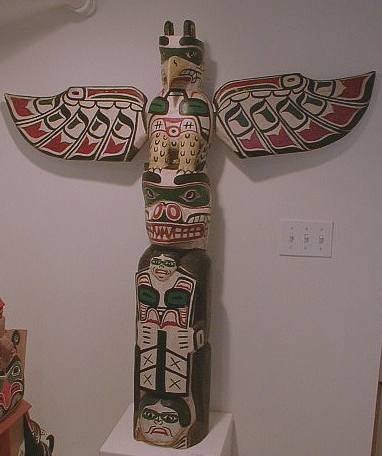


Pole By Chief George Walkus; see another below |
A tiny George Walkus pole |

